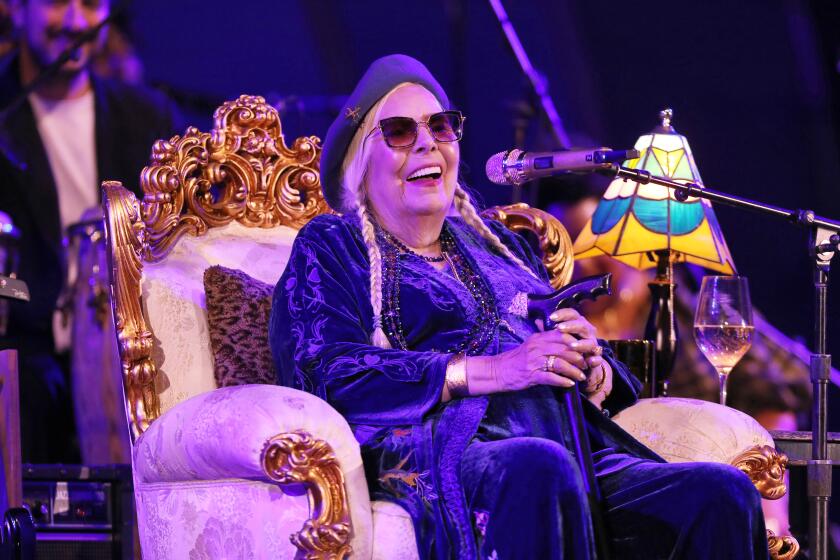Appreciation: Bobby Hutcherson connected some of the highest points in jazz
After spending decades as a marginalized genre, jazz has something of an internal obsession with providing entry points. If the right album gets into the right hands at the right time, the thinking goes for listeners of jazz and all music worth exploring, another fan is born.
It’s an irresistible proposition, so here’s another to consider: If you’ve ever been curious about jazz, look for Bobby Hutcherson’s name on just about any album. If he’s present as a sideman or a leader, you’ll most likely be well on your way.
Hutcherson, who died at 75 on Monday at his home outside San Francisco, is an artist whose career reveals him as something akin to connective tissue in jazz, a vital conduit for and contributor to further exploration.
His chosen instrument, the vibraphone, does not carry the same iconic history as the piano, trumpet or saxophone — surely the first sounds newcomers to jazz hear with associations to names so immortal they all became singular in their own right: Monk, Ornette, Miles, Coltrane, Bird, Sonny.
See the most-read stories in Entertainment this hour »
Hutcherson was far from the first to adapt the vibraphone to jazz — Lionel Hampton, Cal Tjader and Milt Jackson are just a few others — but he was a key contributor to the ‘60s avant-garde and post-bop, and his list of recordings reads like a canon in the Blue Note Records catalog.
His recorded output forms a tidy line through some of the most groundbreaking albums in jazz. On Eric Dolphy’s classic album “Out to Lunch,” a record released in 1964 but so singular it still sounds alien, Hutcherson’s vibes deliver both declarations and punctuation around Dolphy’s knotted melodies.
At one point he’s tracing odd-angled figures though the opening track “Hat and Beard,” and in the next he stabs a tone so unexpected it resembles an impatient poke at a doorbell. And then he does it again, and it’s so perfectly strange that no other tone could have been in its place.

On Granchan Moncur III’s revered 1963 album “Evolution,” Hutcherson’s vibraphone could shiver around the margins yet still press a song forward, and in that same year offered a shape-shifting melodic counterweight to saxophonist Jackie McLean’s propulsive recording “Destination … Out!” Andrew Hill, Joe Henderson, Grant Green and Tony Wilson are just a few more with hall of fame-level ‘60s recordings that featured Hutcherson.
None of this is to discount Hutcherson’s output as a leader. His 1965 debut, “Dialogue,” is part of the Blue Note canon of jazz releases with a band that includes Hill and trumpeter Freddie Hubbard and a richly tangled sound that acts as nearly a companion piece to “Out to Lunch.” The follow-up “Components” splits the difference between his rich ear for melody with “Tranquility” and “Little B’s Poem” and an unfettered, free-blowing second half with tracks written by drummer Joe Chambers.

In the late ‘60s and ‘70s, the Los Angeles-born, Pasadena-raised Hutcherson returned to California after losing his cabaret card in New York City. He began recording with saxophonist Harold Land, and eventually his sound evolved into head-bobbing fusion on albums like “San Francisco.”
His 1971 album “Head On” combined that hard-hitting funk sound with orchestral ambition, and its expanded 2008 reissue should be required listening for crate-digging psychedelic funk fans in the orbit of the Brainfeeder label.

Even after being diagnosed with emphysema late in life, he could scale remarkable heights. He was one of the first members of the SFJAZZ Collective with rising stars Joshua Redman and Nicholas Payton, and still sounded strong on his 2012 live recording “Somewhere in the Night” and “Enjoy the View,” a 2014 album with David Sanborn that was his last release as a bandleader.
While Hutcherson’s imaginative legacy offers multiple points of introduction to some of the most unforgettable sounds in jazz, it’s also so expansive that it nearly requires a recommended entry point all its own. Fortunately, there is no wrong answer.
Follow me over here @chrisbarton.
ALSO:
‘Innovative’ jazz vibraphonist Bobby Hutcherson dies at 75
Garrison Keillor brings ‘A Prairie Home Companion’ to a close at the Hollywood Bowl
Notes of brilliance heard at the Playboy Jazz Festival
More to Read
The biggest entertainment stories
Get our big stories about Hollywood, film, television, music, arts, culture and more right in your inbox as soon as they publish.
You may occasionally receive promotional content from the Los Angeles Times.











